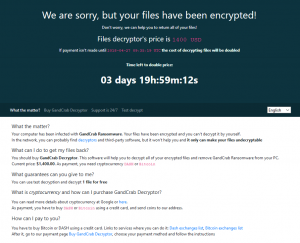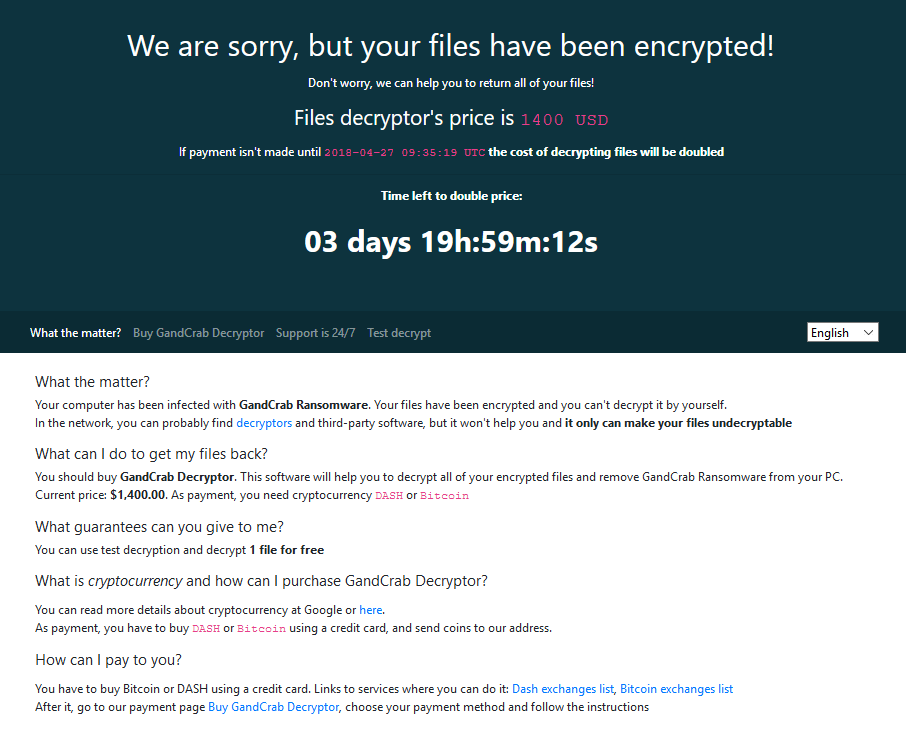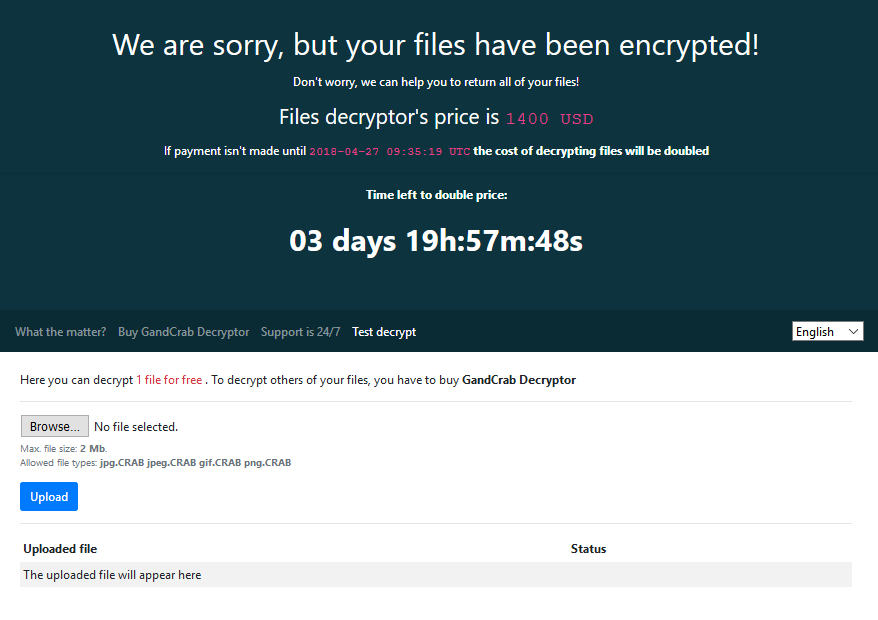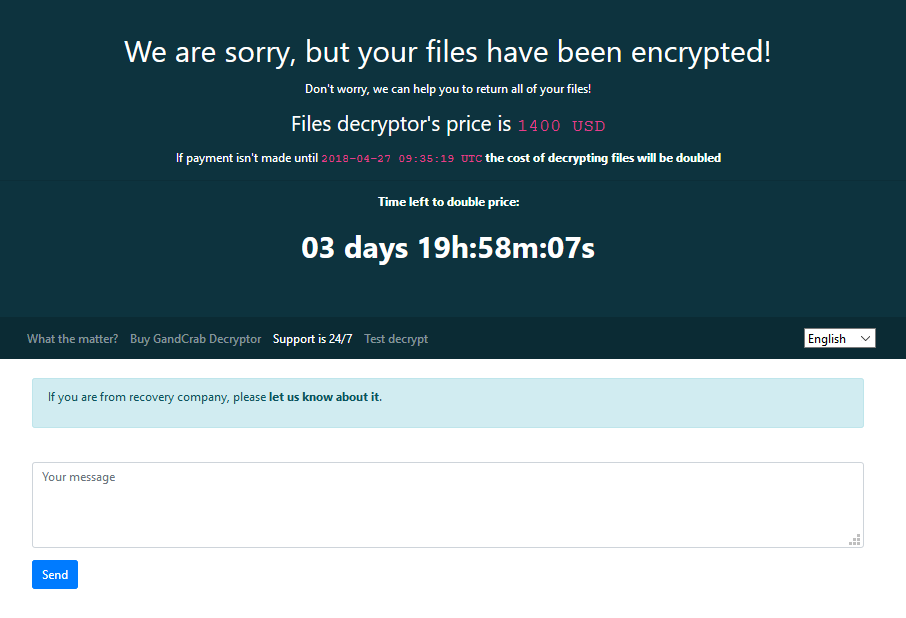This article aims to explain what exactly is the GANDCRAB V2.1 ransomware virus and show how to remove and restore .CRAB encrypted files on your computer.
A newer version of GandCrab v2 ransomware has been detected in the wild, calling itself GANDCRAB V2.1. The ransomware virus uses the .CRAB file extension which it gladly ads as soon as it make sure that they are no longer able to be opened and seem corrupt.
The GANDCRAB V2.1 malware can cause you quite the headaches after it infects your PC, because it wants you to pay ransom in the first ever use of the DASH cryptocurrency in conjunction with ransomware infection. So if your computer has been infected by GANDCRAB V2.1 ransomware, stay tuned and read this article to see how to make sure this threat does not exist anymore on your computer and how you can try and restore as many encrypted files as possible without paying an actual ransom.

Threat Summary
| Name | GANDCRAB V2.1 Ransomware |
| Type | Ransomware, Cryptovirus |
| Short Description | Version of GandCrab ransom virus family. Encrypts your files and asks you to pay in ransom “fee” in the DASH cryptocurrency. |
| Symptoms | Encrypted files carry the .CRAB suffix and cannot be opened. A ransom note, named CRAB-DECRYPT.txt is dropped on your PC. |
| Distribution Method | Spam Emails, Email Attachments, Executable files |
| Detection Tool |
See If Your System Has Been Affected by malware
Download
Malware Removal Tool
|
User Experience | Join Our Forum to Discuss GANDCRAB V2.1 Ransomware. |
| Data Recovery Tool | Windows Data Recovery by Stellar Phoenix Notice! This product scans your drive sectors to recover lost files and it may not recover 100% of the encrypted files, but only few of them, depending on the situation and whether or not you have reformatted your drive. |

.CRAB Ransomware – Update July 2018 (New Version 4 Released)
A new version of the GandCrab ransomware virus has been detected in the wild, going by the name GANDCRAB V4. You can learn more about it from the following research, removal and file recovery article:
Recent information about the .KRAB v4 ransomware has come to our attention. The malware researcher, known as Brad from Malware-Traffic-Analysis has detected newer and newer e-mails to be used to spread the infection file of the latest GandCrab ransomware virus variants. This time, the cyber-criminals were detected to use a JavaScript file, posing as an actual PDF type of file. The file, is contained in a 7z archive and was reported by Brad on his block malware-traffic-analysis.net, to be spread via the following e-mail addresses:
E-mails spreading GandCrab 2.0:
Adolfo70@5348.com
Ahmad26@2336.com
Aileen65@9033.com
Beulah34@1490.com
Billy20@4425.com
Billy11@4302.com
Blaine98@8771.com
Deanna62@5595.com
Glenna52@2606.com
Tara72@1753.com
The ransomware infection e-mails were also reported by Brad to contain the following topics (Subjects):
Document #{number}
Invoice #{number}
Order #{number}
Payment #{number}
Payment Invoice #{number}
Payment Invoice #{number}
Ticket #{number}
Your Document #{number}
Your Order #{number}
Your Ticket #{number}
The e-mails are reported to contain files which are 7zip archives (.7z) and have name, like the following:
→ DOC249127923-PDF.7z
When the victims opens and extracts the file, it has the absolutely same name, however is a .js (JavaScript) type of file. This is the file which actually infects your computer. Even extracting this file from the 7z archive may risk the health of your files:
→ DOC249127923-PDF.js
If you have an e-mail service which contains a blacklist function, it is important that you add those e-mails to your blacklist and if you see such e-mails, beginning with a name, a number and then something like “@12412312.com”, do not even open them. If you want to check whether or not they are malicious you can just go ahead and forward them to free services, like ZipeZip, which will perform a check for you without you having to open the e-mails.

GANDCRAB V2.1 How Does It Infect
The malware researcher Brad at Malware-Traffic-Analysis has detected the GANDCRAB ransomware infection to be spread via malicious e-mails used to carry JavaScript files. The files pretend as if they are legitimate PDF files, and they are archived within .7z types of files. The e-mails contain the following information:
From: {Fake name and e-mail address}
Subject: Payment Invoice #(number)Dear Customer,
To read your document please open the attachment and reply as soon as possible.
Kind regards
TCR Customer Support
The attachment carries an archive which appears like the following:
![]()
The subjects of the e-mail are also reported to possibly be according to the following templates:
Document #{number}
Invoice #{number}
Order #{number}
Payment #{number}
Payment Invoice #{number}
Payment Invoice #{number}
Ticket #{number}
Your Document #{number}
Your Order #{number}
Your Ticket #{number}
When the victim opens the .7z archive, he or she finds a file with the same name as the archive, only in .js file type, for instance:
→ DOC249127923-PDF.7z – the archive.
DOC249127923-PDF.js – the file within it.
If you work with e-mails on a daily basis, security researchers advise to be careful and always check what you download before actually downloading and opening it. One way to do this is to simply forward the e-mail to an online service that will check whether it’s malicious or not. One such free service is Zipezip.

GANDCRAB V2.1 Ransomware – Analysis
Once the GANDCRAB V2.1 ransomware’s .js file is clicked on, it immediately triggers a malicious JavaScript that results in dropping a malicious executable, located in the %AppData% directory. This executable is reported by security researchers to have the following parameters:
Size: 265,224 bytes
Location: %AppData%\RoamingiqB44.Exe
Besides this name, the .exe file has also been detected under other names as well, but generally has the same location. It can also be detected by creating a Windows Registry entry in the following Windows sub-key:
→ HKEY_CURRENT_USER\Software\Microsoft\Windows\CurrentVersion\RunOnce
In this sub-key, you may encounter a randomly named value string, for example “rzdsiabfbie”. It contains the actual name and location of the malicious executable file.
After infection, GANDCRAB V2.1 malware may attempt to establish connection with one of it’s servers and hosts. Some of those in relation to it’s other variants have been reported to be the following:
→ 92.63.197.59
66.171.248.178
5.104.188.117
188.172.82.30
66.171.248.178
188.172.82.30
90.141.200.228
The ransomware also goes through great efforts to make sure that the victim opens it’s ransom note file, called CRAB-DECRYPT.txt. The ransom note has the following contents:
GANDCRAB v2.1
Attention!
All your files documents. photos databases and other important files are encrypted and have the extension: .CRAB
The only method of recovering files is to purchase a private key. It is on our server and only we can recover your files.
The server with your key is in a closed network TOR. You can get there by the following ways:
0. Download Tor browser – https://www.torproject.org/
1. Install Tor browser
2. Open Tor Browser
3. Open link in TOR browser: https://gandcrab2pie73et.onion/f6e46a9cb4dae302
4. Follow the instructions on this page
If Tor/Tor browser is locked in your country or you can not install it. open one of the following links in your regular browser:{tor links here}
ATTENTION! Use regular browser only to contact us. Buy decrypt or only through TOR browser link or Jabber Bot!
On our page you will see instructions on payment and get the opportunity to decrypt 1 file for free.
The alternative way to contact us is to use Jabber messenger. Read how to:
0. Download Psi-Plus Jabber client: https://psi-im.org/download/
1. Register new account: https://sgams/register.php
0? Enter “username”: {crooks’ provided ID}
1) Enter “password”: your password
2. Add new account in Psi
3. Add and write Jabber ID: ransomwareesj.ms any message
4. Follow instruction bot
It is a bot! It’s fully automated artificial system without human control!
TO contact us use TOR inks. we can provide you all required proofs of decryption available anytime. we are open to conversations.
You can read instructions how to install and use jabber here ttp://www.sfu.ca/jabber/Psi_Jab er_Pc.pdf
DANGEROUS!
Do not try to modify files or use your own private key – this will result in the loss of your data forever!
The malicious web links to which the virus aims to lead the victim lead to a website which is pretty well designed, I have to admit. The site welcomes you with the following ransom note:

The web page even has some advanced features, such as a feature to help you test the decryption software:

GANDCRAB V2.1 also has 24/7 support in order to establish communications with the cyber-criminals behind this ransomware.


GANDCRAB V2.1 Ransomware – Encryption
The encryption process of this ransomware infection is rather the standard one, involving a sophisticated encryption algorithm which alters portions of the original file’s data, enough to make it no longer able to be opened. The files which may be attached by this version of GANDCRAB V2.1 ransomware are often used types of files, like documents, images, videos, archives and other types of files. The encryption mode is reported to be the RSA encryption algorithm, also known as Rivest-Shamir-Adleman. It aims to generate a unique decryption key for each file or set of files, making them significantly harder to decrypt. Some of the files which are attacked by GANDCRAB V2.1 are reported by malware researchers to be among the following file list:
→“PNG .PSD .PSPIMAGE .TGA .THM .TIF .TIFF .YUV .AI .EPS .PS .SVG .INDD .PCT .PDF .XLR .XLS .XLSX .ACCDB .DB .DBF .MDB .PDB .SQL .APK .APP .BAT .CGI .COM .EXE .GADGET .JAR .PIF .WSF .DEM .GAM .NES .ROM .SAVCADFiles .DWG .DXFGISFiles .GPX .KML .KMZ .ASP .ASPX .CER .CFM .CSR .CSS .HTM .HTML .JS .JSP .PHP .RSS .XHTML.DOC .DOCX .LOG .MSG .ODT .PAGES .RTF .TEX .TXT .WPD .WPS .CSV .DAT .GED .KEY .KEYCHAIN .PPS .PPT .PPTX ..INI .PRFEncodedFiles .HQX .MIM .UUE .7Z .CBR .DEB .GZ .PKG .RAR .RPM .SITX .TAR.GZ .ZIP .ZIPX .BIN .CUE .DMG .ISO .MDF .TOAST .VCDSDF .TAR .TAX2014 .TAX2015 .VCF .XMLAudioFiles .AIF .IFF .M3U .M4A .MID .MP3 .MPA .WAV .WMAVideoFiles .3G2 .3GP .ASF .AVI .FLV .M4V .MOV .MP4 .MPG .RM .SRT .SWF .VOB .WMV3D .3DM .3DS .MAX .OBJR.BMP .DDS .GIF .JPG ..CRX .PLUGIN .FNT .FON .OTF .TTF .CAB .CPL .CUR .DESKTHEMEPACK .DLL .DMP .DRV .ICNS .ICO .LNK .SYS .CFG”
After the encryption process has completed, the victim finds his/her files looking like the following:


Remove GANDCRAB V2.1 and Try Getting Back Your Files
To remove GANDCRAB V2.1 safely, you can help yourself by following the removal instructions underneath. If manual removal is not something you feel confidence in doing with 100% effectiveness, experts do advise to go to the automatic approach and use an advanced anti-malware software for the removal. Such will ensure that you remove GANDCRAB V2.1 completely and that your PC is fully secure against any threats or intrusive software.
Let’s be frank – decryption that is valid for the RSA encryption algorithm is only available in two cases – if malware researchers crack GANDCRAB V2.1 or if the cyber-criminals behind the infection leak the decryption keys. But this should not despair you because there are still ways to recover most of your encrypted files. We have published some of those alternative methods underneath in step “2. Restore files, encrypted by GANDCRAB V2.1”. They can help you to restore some of those encrypted files, but keep in mind that it depends a lot on the post-infection condition of your PC.
- Step 1
- Step 2
- Step 3
- Step 4
- Step 5
Step 1: Scan for GANDCRAB V2.1 Ransomware with SpyHunter Anti-Malware Tool



Ransomware Automatic Removal - Video Guide
Step 2: Uninstall GANDCRAB V2.1 Ransomware and related malware from Windows
Here is a method in few easy steps that should be able to uninstall most programs. No matter if you are using Windows 10, 8, 7, Vista or XP, those steps will get the job done. Dragging the program or its folder to the recycle bin can be a very bad decision. If you do that, bits and pieces of the program are left behind, and that can lead to unstable work of your PC, errors with the file type associations and other unpleasant activities. The proper way to get a program off your computer is to Uninstall it. To do that:


 Follow the instructions above and you will successfully delete most unwanted and malicious programs.
Follow the instructions above and you will successfully delete most unwanted and malicious programs.
Step 3: Clean any registries, created by GANDCRAB V2.1 Ransomware on your computer.
The usually targeted registries of Windows machines are the following:
- HKEY_LOCAL_MACHINE\Software\Microsoft\Windows\CurrentVersion\Run
- HKEY_CURRENT_USER\Software\Microsoft\Windows\CurrentVersion\Run
- HKEY_LOCAL_MACHINE\Software\Microsoft\Windows\CurrentVersion\RunOnce
- HKEY_CURRENT_USER\Software\Microsoft\Windows\CurrentVersion\RunOnce
You can access them by opening the Windows registry editor and deleting any values, created by GANDCRAB V2.1 Ransomware there. This can happen by following the steps underneath:


 Tip: To find a virus-created value, you can right-click on it and click "Modify" to see which file it is set to run. If this is the virus file location, remove the value.
Tip: To find a virus-created value, you can right-click on it and click "Modify" to see which file it is set to run. If this is the virus file location, remove the value.
Before starting "Step 4", please boot back into Normal mode, in case you are currently in Safe Mode.
This will enable you to install and use SpyHunter 5 successfully.
Step 4: Boot Your PC In Safe Mode to isolate and remove GANDCRAB V2.1 Ransomware





Step 5: Try to Restore Files Encrypted by GANDCRAB V2.1 Ransomware.
Method 1: Use STOP Decrypter by Emsisoft.
Not all variants of this ransomware can be decrypted for free, but we have added the decryptor used by researchers that is often updated with the variants which become eventually decrypted. You can try and decrypt your files using the instructions below, but if they do not work, then unfortunately your variant of the ransomware virus is not decryptable.
Follow the instructions below to use the Emsisoft decrypter and decrypt your files for free. You can download the Emsisoft decryption tool linked here and then follow the steps provided below:
1 Right-click on the decrypter and click on Run as Administrator as shown below:

2. Agree with the license terms:

3. Click on "Add Folder" and then add the folders where you want files decrypted as shown underneath:

4. Click on "Decrypt" and wait for your files to be decoded.

Note: Credit for the decryptor goes to Emsisoft researchers who have made the breakthrough with this virus.
Method 2: Use data recovery software
Ransomware infections and GANDCRAB V2.1 Ransomware aim to encrypt your files using an encryption algorithm which may be very difficult to decrypt. This is why we have suggested a data recovery method that may help you go around direct decryption and try to restore your files. Bear in mind that this method may not be 100% effective but may also help you a little or a lot in different situations.
Simply click on the link and on the website menus on the top, choose Data Recovery - Data Recovery Wizard for Windows or Mac (depending on your OS), and then download and run the tool.
GANDCRAB V2.1 Ransomware-FAQ
What is GANDCRAB V2.1 Ransomware Ransomware?
GANDCRAB V2.1 Ransomware is a ransomware infection - the malicious software that enters your computer silently and blocks either access to the computer itself or encrypt your files.
Many ransomware viruses use sophisticated encryption algorithms to make your files inaccessible. The goal of ransomware infections is to demand that you pay a ransom payment to get access to your files back.
What Does GANDCRAB V2.1 Ransomware Ransomware Do?
Ransomware in general is a malicious software that is designed to block access to your computer or files until a ransom is paid.
Ransomware viruses can also damage your system, corrupt data and delete files, resulting in the permanent loss of important files.
How Does GANDCRAB V2.1 Ransomware Infect?
Via several ways.GANDCRAB V2.1 Ransomware Ransomware infects computers by being sent via phishing emails, containing virus attachment. This attachment is usually masked as an important document, like an invoice, bank document or even a plane ticket and it looks very convincing to users.
Another way you may become a victim of GANDCRAB V2.1 Ransomware is if you download a fake installer, crack or patch from a low reputation website or if you click on a virus link. Many users report getting a ransomware infection by downloading torrents.
How to Open .GANDCRAB V2.1 Ransomware files?
You can't without a decryptor. At this point, the .GANDCRAB V2.1 Ransomware files are encrypted. You can only open them once they are decrypted using a specific decryption key for the particular algorithm.
What to Do If a Decryptor Does Not Work?
Do not panic, and backup the files. If a decryptor did not decrypt your .GANDCRAB V2.1 Ransomware files successfully, then do not despair, because this virus is still new.
Can I Restore ".GANDCRAB V2.1 Ransomware" Files?
Yes, sometimes files can be restored. We have suggested several file recovery methods that could work if you want to restore .GANDCRAB V2.1 Ransomware files.
These methods are in no way 100% guaranteed that you will be able to get your files back. But if you have a backup, your chances of success are much greater.
How To Get Rid of GANDCRAB V2.1 Ransomware Virus?
The safest way and the most efficient one for the removal of this ransomware infection is the use a professional anti-malware program.
It will scan for and locate GANDCRAB V2.1 Ransomware ransomware and then remove it without causing any additional harm to your important .GANDCRAB V2.1 Ransomware files.
Can I Report Ransomware to Authorities?
In case your computer got infected with a ransomware infection, you can report it to the local Police departments. It can help authorities worldwide track and determine the perpetrators behind the virus that has infected your computer.
Below, we have prepared a list with government websites, where you can file a report in case you are a victim of a cybercrime:
Cyber-security authorities, responsible for handling ransomware attack reports in different regions all over the world:
Germany - Offizielles Portal der deutschen Polizei
United States - IC3 Internet Crime Complaint Centre
United Kingdom - Action Fraud Police
France - Ministère de l'Intérieur
Italy - Polizia Di Stato
Spain - Policía Nacional
Netherlands - Politie
Poland - Policja
Portugal - Polícia Judiciária
Greece - Cyber Crime Unit (Hellenic Police)
India - Mumbai Police - CyberCrime Investigation Cell
Australia - Australian High Tech Crime Center
Reports may be responded to in different timeframes, depending on your local authorities.
Can You Stop Ransomware from Encrypting Your Files?
Yes, you can prevent ransomware. The best way to do this is to ensure your computer system is updated with the latest security patches, use a reputable anti-malware program and firewall, backup your important files frequently, and avoid clicking on malicious links or downloading unknown files.
Can GANDCRAB V2.1 Ransomware Ransomware Steal Your Data?
Yes, in most cases ransomware will steal your information. It is a form of malware that steals data from a user's computer, encrypts it, and then demands a ransom in order to decrypt it.
In many cases, the malware authors or attackers will threaten to delete the data or publish it online unless the ransom is paid.
Can Ransomware Infect WiFi?
Yes, ransomware can infect WiFi networks, as malicious actors can use it to gain control of the network, steal confidential data, and lock out users. If a ransomware attack is successful, it could lead to a loss of service and/or data, and in some cases, financial losses.
Should I Pay Ransomware?
No, you should not pay ransomware extortionists. Paying them only encourages criminals and does not guarantee that the files or data will be restored. The better approach is to have a secure backup of important data and be vigilant about security in the first place.
What Happens If I Don't Pay Ransom?
If you don't pay the ransom, the hackers may still have access to your computer, data, or files and may continue to threaten to expose or delete them, or even use them to commit cybercrimes. In some cases, they may even continue to demand additional ransom payments.
Can a Ransomware Attack Be Detected?
Yes, ransomware can be detected. Anti-malware software and other advanced security tools can detect ransomware and alert the user when it is present on a machine.
It is important to stay up-to-date on the latest security measures and to keep security software updated to ensure ransomware can be detected and prevented.
Do Ransomware Criminals Get Caught?
Yes, ransomware criminals do get caught. Law enforcement agencies, such as the FBI, Interpol and others have been successful in tracking down and prosecuting ransomware criminals in the US and other countries. As ransomware threats continue to increase, so does the enforcement activity.
About the GANDCRAB V2.1 Ransomware Research
The content we publish on SensorsTechForum.com, this GANDCRAB V2.1 Ransomware how-to removal guide included, is the outcome of extensive research, hard work and our team’s devotion to help you remove the specific malware and restore your encrypted files.
How did we conduct the research on this ransomware?
Our research is based on an independent investigation. We are in contact with independent security researchers, and as such, we receive daily updates on the latest malware and ransomware definitions.
Furthermore, the research behind the GANDCRAB V2.1 Ransomware ransomware threat is backed with VirusTotal and the NoMoreRansom project.
To better understand the ransomware threat, please refer to the following articles which provide knowledgeable details.
As a site that has been dedicated to providing free removal instructions for ransomware and malware since 2014, SensorsTechForum’s recommendation is to only pay attention to trustworthy sources.
How to recognize trustworthy sources:
- Always check "About Us" web page.
- Profile of the content creator.
- Make sure that real people are behind the site and not fake names and profiles.
- Verify Facebook, LinkedIn and Twitter personal profiles.




Hi
Thank you for all useful information provided. However i am asking if there is a program that can perform decryption of infected files.
Thank you
Bonjour, après lecture de ces commentaires, je crois que nous ne sommes pas plus avancés pour effectuer un décryptage de de nos fichiers infectés par ce ransomware.En effet dès que mon PC a été infecté, j’ai acheté une version officielle de SpyHunter4; Après installation et une recherche dans les fichiers, ce soit disant programme miracle n’a rien pu faire de plus.Après plusieurs prises de contact avec les créateurs du logiciel, ceux ci m’ont tout simplement dit qu’il ne pouvaient pas faire plus et m’ont dirigé vers un autre site soit disant capable de le faire. Or ce nouveau site me re demandait de payer dans les 60 € afin de ma’aider. Cela pu l’arnaque, je me suis demander si ces développeurs n’étaient pas à l’origine de certains virus????? Je déconseille fortement à ceux qui sont dans le même cas que moi d’acheter ce logiciel envahissant qui plus est difficile à désinstaller.Cordialement à tous et toutes.
Hi there, SpyHunter is not a ransomware decrypter but an anti-malware program that removes the malware from the infected host. It is not a scam. Unfortunately, there is no universal decrypter for each and every ransomware. It takes time for security experts to develop decryption tools, and what is worse is that even after a decrypter is released, ransomware authors quickly go around it by releasing a new version of their ransomware.
Make sure to invest in data back up and follow the rules of online hygiene to avoid falling victim to ransomware.
Hello
How can i decrypt crab files
I did all these steps but decryption of files not soccessful also by bitefender
What i do
Hi there,
Unfortunately, since there is no official decrypter for the .crab ransomware, there’s also no guarantee you can decrypt your files using alternative methods. Did you try data recovery software as explained in the article above?